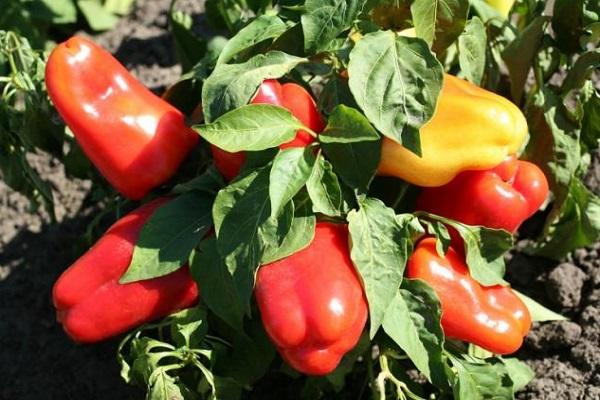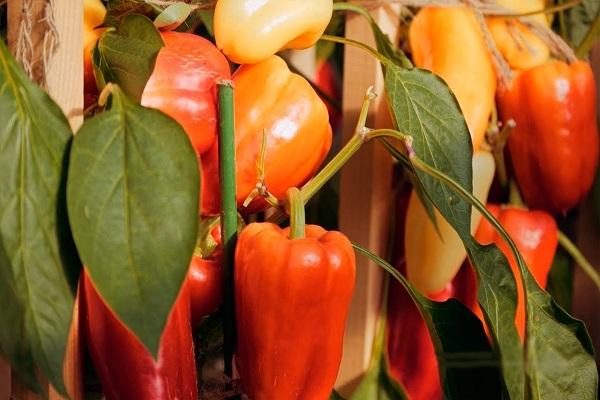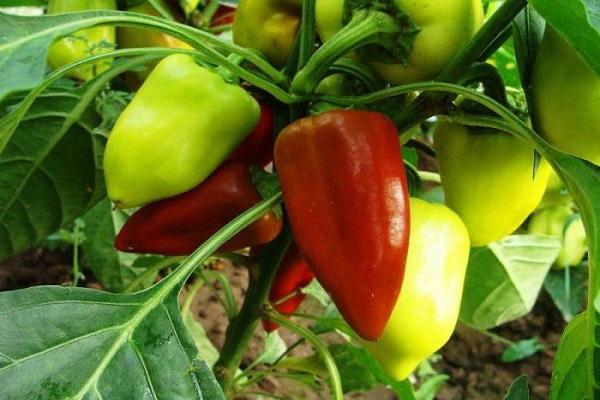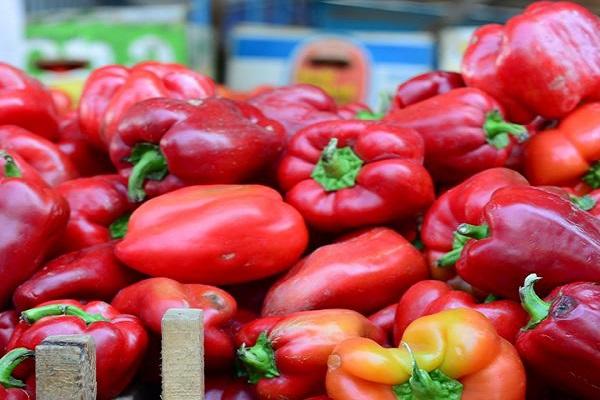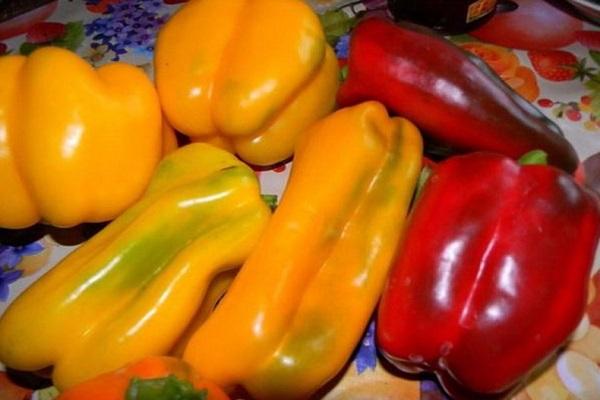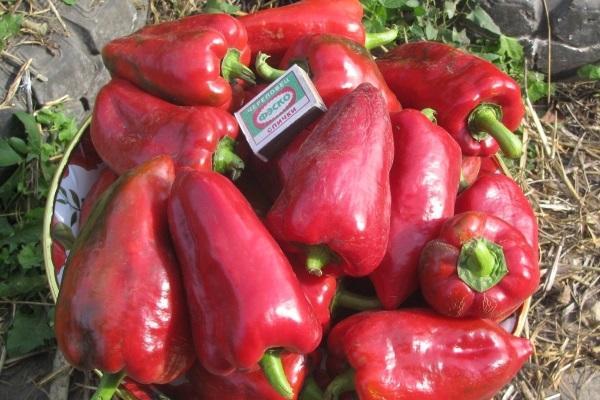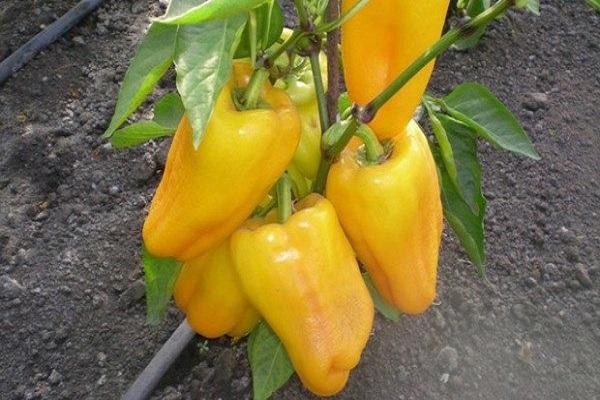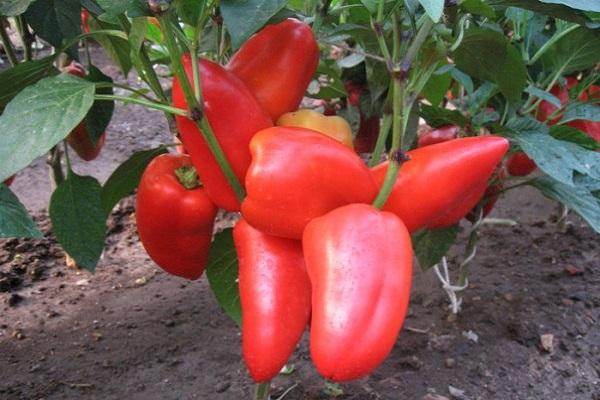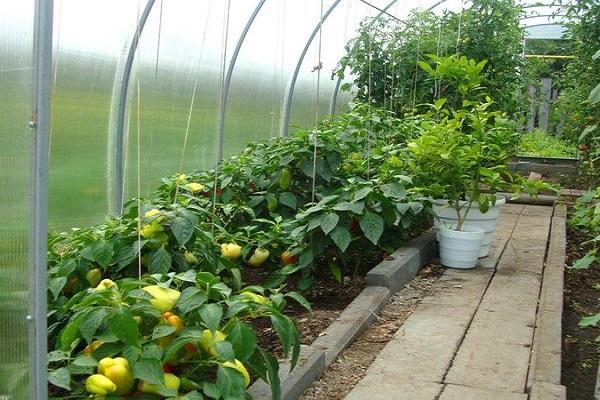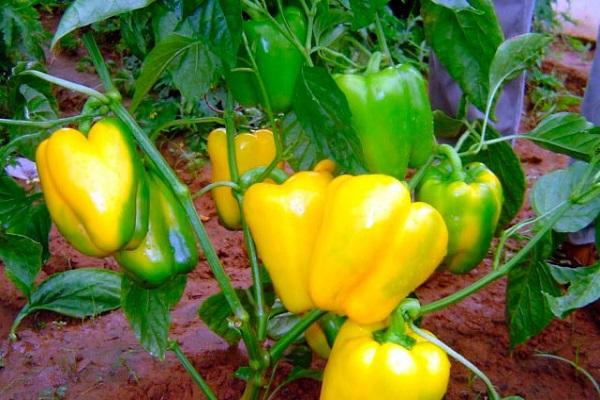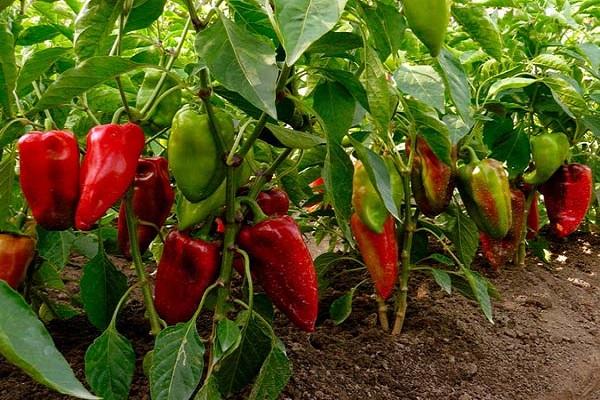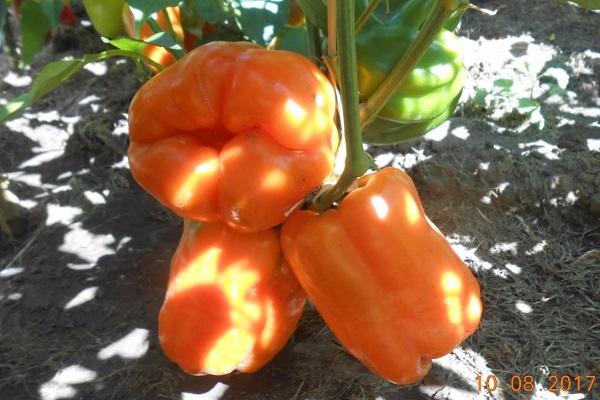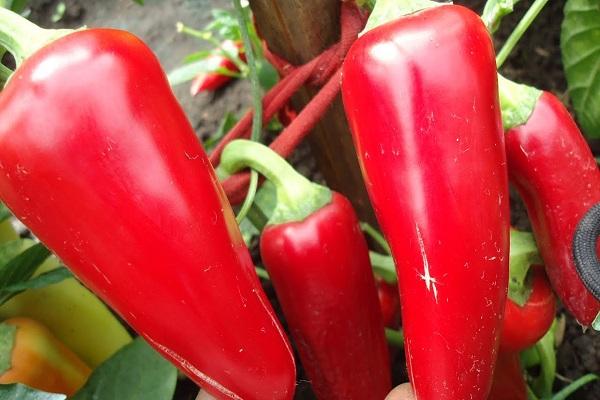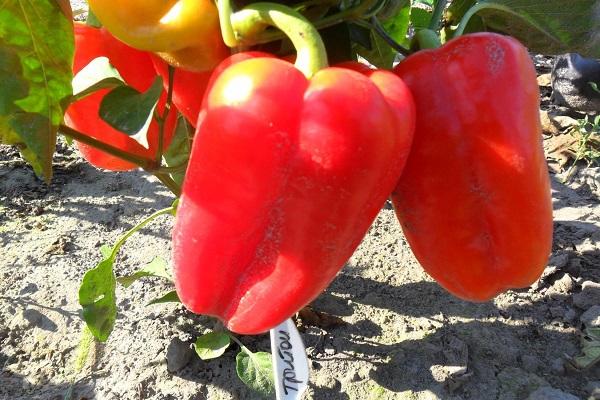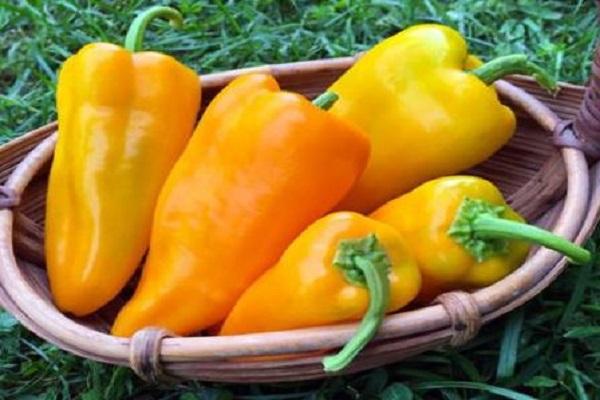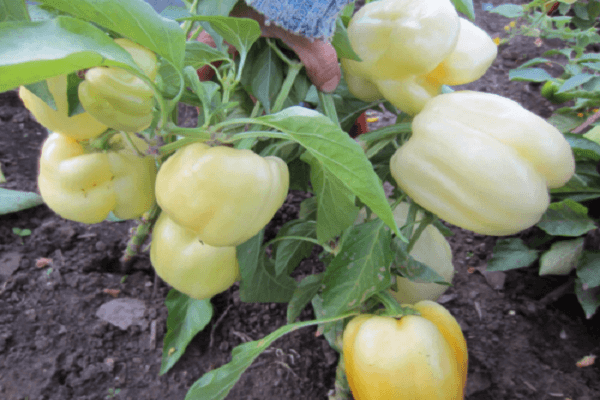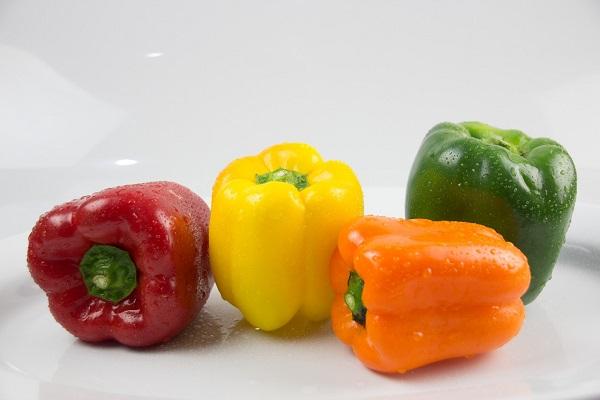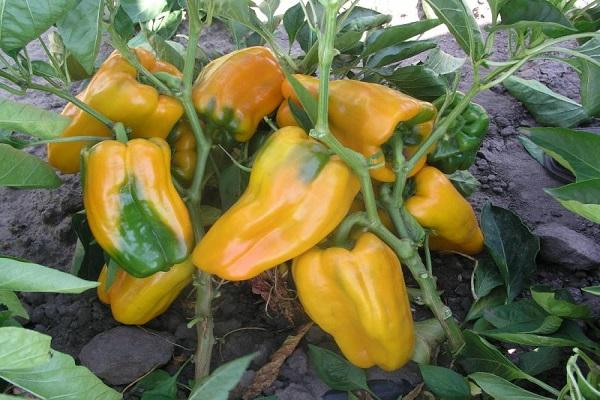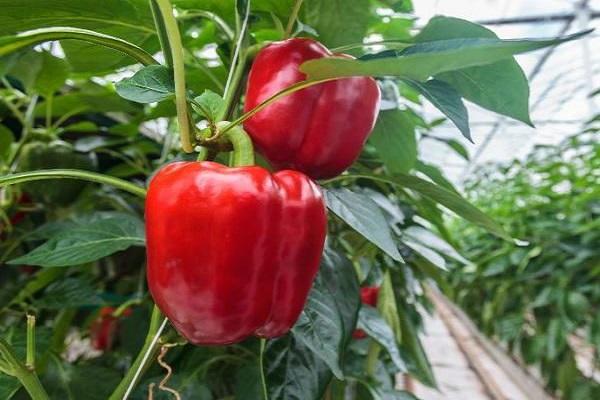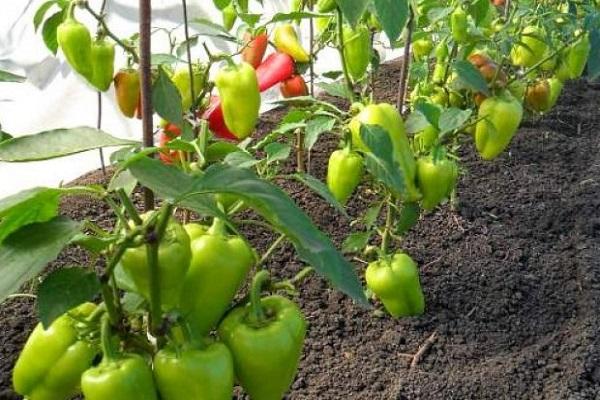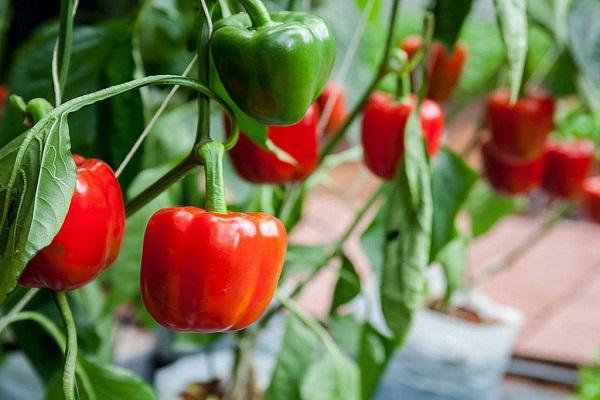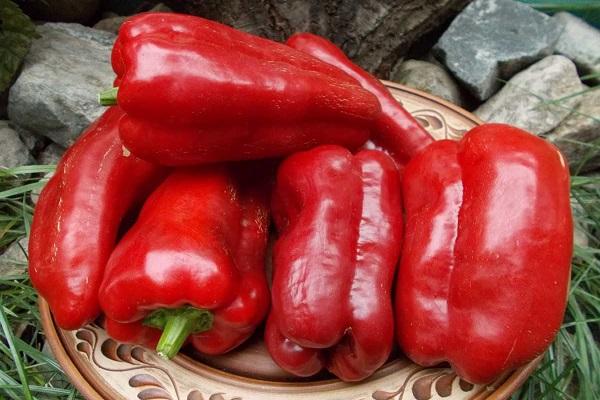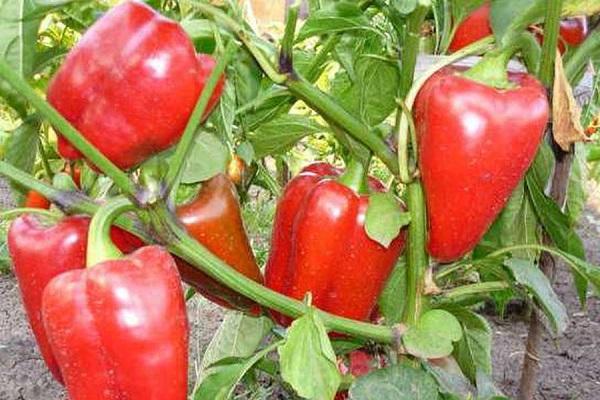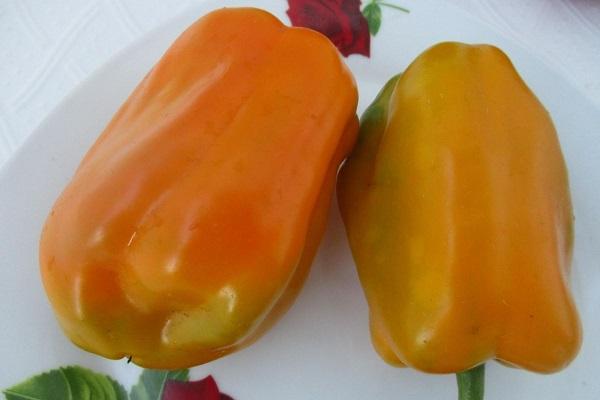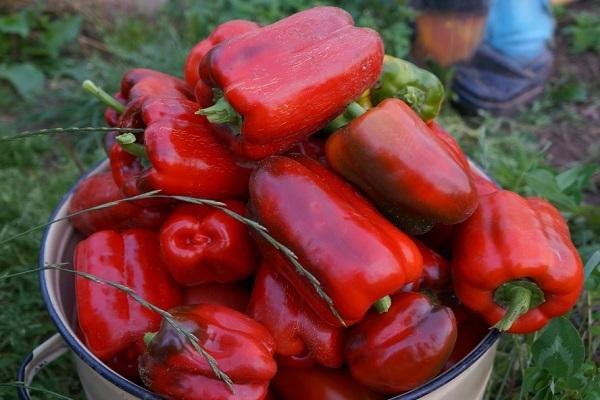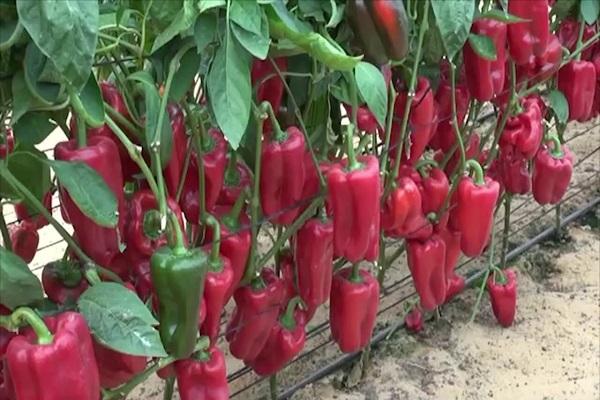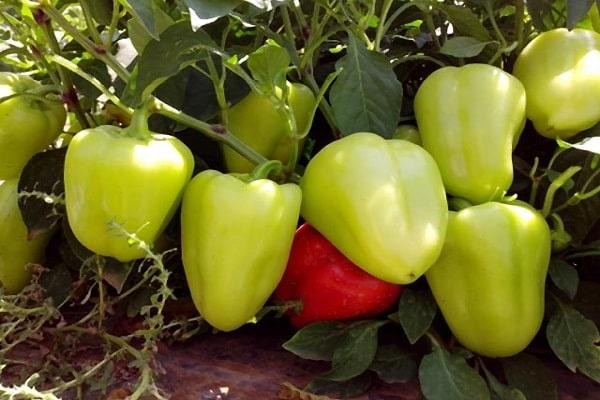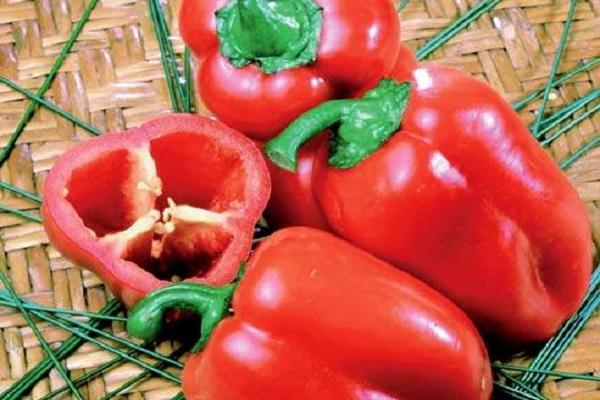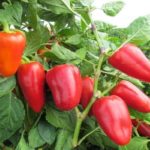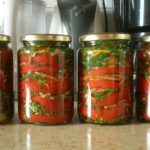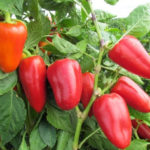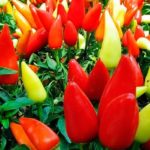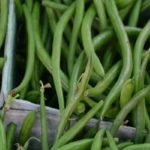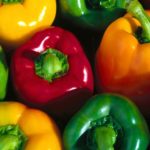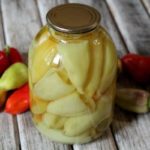The whole truth about the best varieties of pepper in 2024 lies in the availability of seeds from suppliers of early, productive varieties, as well as new hybrids. Sweet peppercorns are invariably present in salads and slices. Home canned food is prepared from them. Information about ripening times and species characteristics will be in demand by different categories of summer residents - both experienced and new.
- Super early varieties of bell peppers for 2024
- Tamara F1
- Sonata F1
- Quickley F1
- Khalif F1
- Early maturing crops worth planting in 2024
- Triton
- Donetsk early
- Merchant
- Montero
- Novorossiysk
- Mid-season types of peppers
- Red and yellow bull
- Atlant
- Description and characteristics of late-ripening varieties
- Marshmallow
- Yellow bell
- Bogatyr
- What is better to plant in polycarbonate greenhouses?
- Chocolate Oriental Star
- Gemini
- Latino
- Night
- Pinocchio
- Popular crops for open ground
- Big mom
- Dandy
- Martin
- Belozerka
- Golden medal
- Triton
- The most productive varieties
- Latino
- Barguzin
- Thick-walled and juicy peppers
- Queen
- Siberian format
- White gold
- ox ear
- Fat Baron
- Bagheera
- White filling
- Quinta F1
- The sweetest varieties
- Gemini F1
- Vasya-Vasilyok F1
- Marshal F1
- Claudio F1
- Tall peppers for open ground and greenhouses
- Merchant
- Fiery
- Snegirek
- Low growing varieties
- New varieties released in 2024
- Rating of the largest species
- The best Dutch peppers
- Good varieties with yellow and orange fruits
- Recommended varieties for planting in the Urals and Siberia
- Golden Taurus
- Sweet chocolate
- Firstborn of Siberia
- Novosibirsk
- Early miracle
- Moneybags
- What to plant in Central Russia
- Boyarin
- Antique dealer
- Arab
- Asti
- Annushka
- Popular varieties for the Moscow region
- Gogoshary
- Victoria
- Kolobok
- Winnie the Pooh
- Agapovsky
- Hercules
Super early varieties of bell peppers for 2024
Each vegetable has its own time. The statement works for any garden crop, with the exception of early, early ripening ones. These species are distinguished by their ability to bear fruit earlier than others, in a short time. Such vegetables will come in handy after a cold winter, when the body is in dire need of vitamin supplementation.
When choosing one variety or another to suit your taste, do not forget to check the “place of registration” with the characteristics: species for the Moscow region are not always suitable for Siberia or the Urals. These regions have different climatic zones, growing seasons, and the length of daylight hours in summer, among other things.
Tamara F1
This variety is classified as mid-early, although it can be considered ultra-early.From the moment of planting seedlings to harvesting ripe peppers, 60-65 days pass. The bush is strong, strong, reaching a height of 70 centimeters. It is characterized by a high density of foliage, which allows it to safely tolerate sharp injections of sunlight.
The pepper is juicy, tasty, and suitable for preservation. The fruits measure up to 16 centimeters in length, 6 in diameter. The weight of one pepper is 100-120 grams. The color of the peel is light, with a green color at the beginning of ripening (technical ripeness) and red at the end (biological). Equally successful will be its use in food in raw (salads, slices) and salted, pickled form.
Sonata F1
The hybrid is intended for growing in greenhouse conditions, under glass or film. The ripening period is from 100 (technical ripeness) to 120 days (biological). The plant is strong, grows up to 2 meters, but requires support. The fruits contain 3-4 chambers and are covered with a glossy peel. As the peppers ripen, they change color from green to deep red. Weight – up to 200 grams. The wall is thick, fleshy, up to 10 millimeters.
Quickley F1
This species ripens equally successfully in 80-90 days in open ground and in a greenhouse. Growth rates are average, the plants do not develop into giants, and at the same time they cannot be classified as dwarfs. The shape of the fruit is cone, weight is up to 120 grams. Mixed color: soft green at technical maturity and bright red at biological maturity. The transition between states is quick, no more than 15 days. Distinctive features of the variety are taste, preservation of presentation, and resistance to transportation.
Khalif F1
The variety is a hybrid variety, produced by the Sakata breeding group. At the beginning of ripening, the fruits are milky white, gradually turn red and gain up to 200 grams.The length of one pepper is up to 100 millimeters, the diameter is 90 with 3-4 chamber voids inside the fruit. Excellent for greenhouses, open ground, transportable. An exceptionally juicy and tasty variety.
Early maturing crops worth planting in 2024
This category contains varieties that are classified as early, but not early ripening. The varieties are ordered according to this characteristic and are suitable for growing in different conditions. Peppers differ in fruit size and peel color and are intended for consumption and canning.
Triton
This species cannot grow successfully in open beds; it is unpretentious and hardy. The bushes are low, up to 50 centimeters. The fruits are small, up to 150 grams. At first the color is bright yellow, after reaching biological ripeness it turns red. Resistant to pathogens of garden diseases.
Donetsk early
The variety is low-growing, hardy and unpretentious. Begins to bear fruit 4 months after hatching. The shape of the fruit is conical, with a rounded tip. Peppers are not susceptible to fungal attacks; their characteristics are compared to Topolin and Kolobok.
Merchant
This species has small fruits, weighing up to 70 grams. They appear 80 days after successful sowing. Peppers have a high content of vitamin C, the flesh is juicy, and the wall thickness is average (up to 7 millimeters). The main advantage of the variety is early ripening.
Montero
Acceleration among peppers: bushes stretch up to 1.2 meters in height. The fruits are massive, weighing up to 260 grams, with a wall of about 7 millimeters. There are known cases when giants grew up to a kilogram on Montero. It belongs to the productive subspecies and is valued by gardeners for its taste characteristics.
Novorossiysk
An early ripening variety. The harvest is ready for harvest in 3 months.The bushes feel great in greenhouses and grow to a height of 1 meter. The fruits are small, bright red, weighing about 60 grams. The wall is moderately thick, up to 6 millimeters. From one square meter of plantation up to 4 kilograms of aromatic, juicy peppers are obtained.
Mid-season types of peppers
Mid-ripening varieties are a reasonable “golden mean”: they ripen not too early, but not too late. These types also “beat” their competitors with excellent taste: juicy, sweet, without the slightest admixture of bitterness. Experienced gardeners cultivate several varieties with different ripening periods. Due to this, they harvest throughout the summer season.
Red and yellow bull
Red belongs to specially bred large-fruited hybrid varieties. It takes root well in greenhouses, hothouses, and open beds. Tested for strength in the Southern and Central zones of the Russian Federation. Juicy, sweet, the fruit weighs up to 250 grams and is up to 20 centimeters long. The pepper is thick-walled (up to 10 millimeters), but not too hard. The peel is medium hard, with a glossy sheen.
Yellow is also not a pure variety, but a hybrid, in the production of which special attention was paid to the size of the pepper and the weight of the fruit. Both breeders and amateurs are satisfied with the result: the length of the vegetable is 20 centimeters, the thickness of the pulp at the cut is 1 centimeter. The average weight of “enhanced” fruits is up to 250 grams, and this is not the limit. There are specimens weighing up to 400 grams.
The skin of such a giant is surprisingly thin and soft. When ripe, Red Bull and Yellow Bull fill with juice and become, respectively, bright red and deep yellow in color.
Atlant
The Atlant variety is considered productive, and it is also highly resistant to standard garden diseases.The growing season is about 75 days, this is the early group in terms of ripening. With the compact size of the bush, quite large fruits develop on it, up to 200 millimeters or more in length.
Another obvious advantage of the species is juicy, tasty peppers with a soft wall, up to 1 centimeter thick. When the fruits are finally ripe, they acquire a rich red color. The shape is conical, the weight of one pepper is up to 150 grams.
Description and characteristics of late-ripening varieties
Late varieties differ from others for the better, since sweeter and tastier peppers cannot be found. The only limitation is that this species does not ripen in every climate; it cannot be grown in cold regions. But in the southern and middle ones - please. Along with early and mid-season varieties, late varieties are deservedly popular among gardeners.
Marshmallow
The Zephyr species is somewhat capricious: the best results are achieved with it by growing bushes under film or agrofibre. The plant is stable and does not require additional support. The shape of the fruit is a classic cone, the weight of one joke is up to 170 grams. The pepper is juicy, soft, exceptionally tasty, with a characteristic aroma. The vegetables are green at first and gradually turn bright red as they ripen. Suitable for food and home canned preparations.
Yellow bell
The bushes are medium-sized, equally good for growing in open space and in greenhouses. The seedlings take root well, the plant height is up to 75 centimeters. The shape of the pepper is cubic, the size of the fruit is up to 110 millimeters. The wall is moderately thick, up to 9 millimeters. The color successively changes from salad green to honey yellow. The pulp is juicy and sweetish.
Bogatyr
The plant fully lives up to its name, growing up to 80 centimeters in height. Peppers are cone-shaped, weighing up to 200 grams. The wall thickness is small, about 5 millimeters. When ripe, the fruits change from green to red. Bogatyr does not mature quickly: within 4-5 months. But one square meter of plantation brings up to 8 kilograms of harvest.
The variety feels good both in open ground and in a greenhouse. Resistant to pathogens and fungi. Transportable, well preserved after collection without losing commercial characteristics. The fruits are rich in vitamin C.
What is better to plant in polycarbonate greenhouses?
There are many different design and material options for greenhouses, both traditional (film, glass) and modern (polycarbonate). Polymers can compete with glass in terms of light transmission, but they weigh much less and are more convenient to install. The big plus is that from April to late autumn (November), vegetable crops can feel safe, reliably protected from external influences. In a “plastic” greenhouse the following are successfully grown:
- Tomatoes.
- Cucumbers.
- Peppers.
That is, under these conditions, vegetables grow no worse, or even better, than in standard greenhouses covered with glass and film. Considering the ideal growing conditions, early, middle and late varieties of pepper are planted in a polycarbonate greenhouse - all of them are guaranteed to ripen and bring a bountiful harvest.
Chocolate Oriental Star
A bright representative of a mid-season variety. It also has record-breaking yields, large, massive fruits weighing up to 350 grams. As the peppers ripen, they acquire a slight hint of chocolate in addition to the bright red. Technical ripeness is characterized by a dark green color.At all stages of ripening, pepper has a characteristic aroma, is juicy and tasty.
Gemini
This variety is suitable for cultivation in open ground, in greenhouses under film. The bushes grow low but strong, up to 40 centimeters. The main thing is to take into account the timing of planting seedlings in order to have time to move the peppers to the garden. After the “high” types, this one requires a specific approach.
First of all, the plant needs a garter. But not a standard one, but a gentle one, one in which the integrity of the stem is not violated. Otherwise, wilting will begin and the pepper may die. Low bushes tolerate growing in film tunnels and produce a plentiful and regular harvest of sweet peppers for salads and canning.
Latino
A hybrid variety with early ripening fruit harvest. No more than 110 days pass from the sprouts to the ripening of the peppers. Experienced gardeners use this quality by sowing seeds for seedlings in early spring (March). By June, sweet, juicy vegetables are ready for the table. The fruits are large, massive, weighing up to a quarter of a kilogram each. They can easily withstand storage and transportation and do not lose their commercial characteristics.
Night
Unique look with unusual coloring. Ripening period – 145 days. The fruit is slightly curved, with an average wall thickness (up to 7 millimeters). The color of ripe pepper is rich purple, rare. The bushes develop actively, rising to a height of up to one and a half meters. They need support. The variety belongs to the salad variety and is successfully cultivated in greenhouse conditions.
Pinocchio
A variety of domestic selection, obtained at the Edelstein vegetable station. Zoning was carried out in 1995, in the center, in the north-west, in the black earth region. Full maturation occurs in the period of 88-100 days.Characteristic features of the species: unpretentiousness, suitability for greenhouse and open breeding conditions. The bushes are tall, up to 100 centimeters in height. Branching is not strong, 2-3 shoots. The fruits are distinguished by their good appearance, juicy taste, productivity and serious size.
Popular crops for open ground
“Open” peppers, by default, are more resilient than sissies from greenhouses, and are better able to withstand attacks from pathogens and pest attacks. As a result, the gardener should receive juicy, sweet fruits for a variety of uses - cutting, salads, canning.
There are also species that are grown both under film or glass and in natural conditions without consequences.
Big mom
This species is rare for Russia. The variety with a bright orange color is a product of domestic selection. For pepper, the color is unusual and unusual, which does not affect the taste or technical characteristics of the fruit. According to laboratory studies, the color orange is strongly associated with sweetness because these vegetables contain beta carotene. Big Mama is good for health, recommended for heart disease, and for strengthening blood vessels. These peppers are also juicy and tasty; they are successfully used raw and canned.
Dandy
Medium-sized bushes bred in Western Siberia and adapted for harsh climates. Peppers are distinguished by their honey-yellow color and fruit shape (slightly swollen, reminiscent of a barrel). The vegetables are large, weighing up to 200 grams, with a wall thickness of 7 millimeters. Agronomists, in addition to endurance and unpretentiousness, have achieved decent commercial characteristics from Shchegol.
Martin
A species that develops not upward, but outward: bushes with a pronounced spreading form of growth. The height reaches 60 centimeters; the pepper needs additional support.According to its characteristics, the variety is of medium ripeness and reaches the technical level at 116-120 days. Swallow has a good yield: the square world of the plantation will yield up to 5 kilograms of sweet pepper.
The shape of the fruit is a classic, slightly inflated cone. The wall is from 5 to 7 millimeters, the color is bright red. The length of ripe specimens is up to 100 millimeters, weight is up to 100 grams. Positioned as an easy to grow variety.
Belozerka
A productive variety with an average harvest time. It would be more correct to call Belozerka a hybrid. The bush grows up to 70 centimeters in height, the fruits are first yellow, then gradually turn red. Resistant to pests and diseases, extremely tasty, with an emphasized sweet note and juicy pulp.
Golden medal
Excellent grown in field conditions, open ground. The height of the bush is up to 1 meter. The fruits are red in color, straight in configuration, up to 13 centimeters in length and weighing up to 50 grams. The wall is of moderate thickness, no more than 4 millimeters. The species is classified as early ripening.
Triton
Triton, with its compact bush size, grows bright red, sweet peppers. Unpretentious, ripens early. The weight of the fruit is up to 150 grams, the wall is medium. The pulp is juicy, suitable for salads and canning.
The most productive varieties
High-yielding species are always of particular interest to agronomists, since, other things being equal, they produce more fruits from one bush.
Latino
Refers to powerful, especially productive hybrid varieties. Not susceptible to the tobacco mosaic pathogen. In the south it is grown in garden beds, in other regions - in greenhouses. The height of the bush is average, the fruit is massive (20 grams or more), red and sweet.
Barguzin
The variety begins to bear fruit 95-130 days after germination.The fruits are green when technically ripe, yellow when biologically ripe. Bush of direct orientation, with slight branching. The height of an adult plant is up to 1 meter. The fruits are conical, weighing up to 200 grams, with a length of 15-17 centimeters. The wall is moderately thick, up to 6 millimeters.
Thick-walled and juicy peppers
The “fat ones” have their own advantages: more juicy sweet pulp, weight, size. Every fan would want to have these peppers in their garden, regardless of length and experience.
Queen
"Royal" variety of pepper. Combines abundant yields with good transport tolerance. The fruits are medium-sized, bright scarlet, weighing up to 200 grams. Good raw and canned.
Siberian format
The bushes are tall, strong, and the fruits match them: the weight of one pepper, with proper feeding, reaches half a kilogram. Ripening time is average.
White gold
Contrary to the name, the fruits of White Gold are not white, but yellow. They differ in size and weight. Each pepper is cube-shaped and weighs up to 450 grams.
ox ear
Universal variety. It can be grown both in a greenhouse and in a garden bed. The height of the bush is up to 70 centimeters. The fruits are elongated, red, average length is about 12 centimeters and weighs 150 grams.
Fat Baron
A mid-early variety of sweet pepper. Sings in 130 days. The wall is moderately thick, up to 6 millimeters, the weight of the fruit is 150 grams. Not particularly productive, but versatile in terms of place of cultivation and use.
Bagheera
A variety with dark (almost black) fruits of medium size. The bushes are small, no higher than half a meter. It grows in garden beds and in greenhouses; the fruits ripen in 120 days.
White filling
This is not an apple, but a variety of sweet pepper. Unpretentious, attractive in appearance, not requiring special care. Suitable for both Siberia and the Moscow region. Ripens in 95-120 days.
Quinta F1
A common hybrid, often called bell pepper. Early, grown in greenhouse conditions and in the garden. Ripeness time is up to 105 days technically and up to 115 days biologically. Has amazing taste characteristics.
The sweetest varieties
Among the variety of types of pepper crops, both the exceptionally large and the most delicious ones stand out. The fruit usually has a slight sourness or signature peppery taste, but breeders have developed varieties that rival the fruit in sweetness. Most of them are hybrids.
Gemini F1
A hybrid of sweet peppers native to the Netherlands. Perfectly adapted to the harsh conditions of cold regions of Russia (Siberia, Ural). It ripens early; on the 72nd day after rooting, the seedlings grow into cubic, robust plants weighing up to 400 grams. Hardy, unpretentious, stress-resistant. The ideal extreme variety.
Vasya-Vasilyok F1
An early ripening hybrid variety intended for a variety of culinary uses. Grows in 100 days (beginning of fruiting). The bushes are tall, up to one and a half meters. The average weight of the fruit is about 250 grams. The peppers are massive, thick-walled, juicy.
Marshal F1
The ripening time for this species is average, up to 130 days. The height is also not outstanding, about 90 centimeters. But the fruits are rightfully considered giants. The length of each pepper is up to 20 centimeters, weight – up to 400 grams.
Claudio F1
Claudio has many advantages: productivity, versatility, early ripening (up to 80 days). One pepper weighs up to a quarter of a kilogram and has a juicy, rich taste. Keeps fresh or frozen for a long time.
Tall peppers for open ground and greenhouses
Tall crops, unlike compact ones, allow you to harvest large fruits and receive more sun and heat.This is their main advantage, which, however, is offset by the need to tie up the stems.
Merchant
According to the growing season (80 days), Merchant is classified as an early ripening species. The fruit is rich in vitamin C, the wall is up to 7 millimeters thick. The size and yield indicators are average; ripe peppers have a rich dark red color.
Fiery
An early variety of garden peppers, ripens in 110 days. The fruiting period is extended, peppercorns gradually change the green color of the peel (technical ripeness) to bright red (biological). The wall is medium, up to 6 millimeters. The fruits are cone-shaped.
Snegirek
The height of this variety is up to 2 meters, the fruits are massive, weighing up to 120 grams. The pulp is juicy, up to 6 millimeters thick. The pepper has a slightly cut tip. The aroma is not pronounced, the taste is sweet and pleasant.
Low growing varieties
Compact species do not shine in size; it is difficult for them to compete with tall ones in terms of height and fruit size. They are used in greenhouses and greenhouses and do not require tying up. Their main advantage is less demanding care. Low yields are skillfully compensated for by plantation density. These are Lisichka, Sveta, Fakir, Agapovsky, Gemini, Ilya Muromets and others.
New varieties released in 2024
Every year, through the efforts of breeders, new, improved species appear. In the next season, it is recommended to try Admiral Kolchak, Admiral Nakhimov, Belogor, Bison (yellow and red), Big Kush, Be Healthy.
Rating of the largest species
Experienced gardeners know that large-fruited species are suitable both for their own consumption and for sale. Often the size of the vegetable is combined with a bountiful harvest, which is doubly beneficial.Among the best varieties are: Kakadu F1, Chocolate Beauty, Bogdan, Goodwin F1 (sweet), Avangard (sweet), Anastasia, Boneta, King Kong.
The best Dutch peppers
Many good varieties have been bred in the Netherlands and are successfully cultivated in Russia. Their advantages lie in stable performance and productivity. Gardeners use Orange Wonder F1, Indalo F1, Montero F1, Pantino F1.
Good varieties with yellow and orange fruits
Among the variety of species, colors, and shapes, yellow and orange varieties stand out. In addition to their unusual color, they have an accentuated sweetish note and a minimal amount of sourness. At the stage of technical ripeness, these species are usually bright green.
Recommended varieties for planting in the Urals and Siberia
Gardeners from “cold” regions often doubt which pepper to plant, so as not to make a mistake with the timing of ripening and the choice of type. Guaranteed to ripen and bring a harvest in Siberia, Goldfinch, Moneybags, Golden Calf, Sweet Chocolate.
Golden Taurus
“Siberian” variety, classified as mid-early, according to ripening time. The peppers are a rich orange hue, cubic, with record thick juicy flesh (up to 2 centimeters).
Sweet chocolate
Exotic pepper: chocolate outside, red inside. The pulp is sweet, juicy, suitable for both home-cooking and raw consumption.
Firstborn of Siberia
One of the early ripening species fully lives up to its name: the harvest can begin to be harvested after 100 days. Resistant to garden diseases.
Novosibirsk
Not large (up to 60 grams), but steadily ripening fruits appear after 95 days. The seeds hatch quickly and produce strong shoots. The wall is medium thick, up to 6 millimeters.Up to 4 kilograms of sweet, aromatic pepper are obtained per square meter.
Early miracle
Early type (vegetative period - 105 days). Unpretentious, resistant to viruses. The bushes are tall, up to 1.2 meters. Ripe peppers are distinguished by the rich red color of their skin and pulp.
Moneybags
A new variety that has proven itself well in cold climates. Not afraid of frost, grows in the garden. The bushes are medium-sized, no higher than 60 centimeters. The color of the ripe fruit is red.
What to plant in Central Russia
The middle zone is no longer Siberia, but not yet the south. You will need to choose unpretentious, hardened types of peppers that can grow and ripen in cool summer conditions. When planting “under film” the task is simplified. Most types of peppers thrive in greenhouses and special tunnels. For the Middle Zone, varieties bred and zoned for cold regions are suitable; they will bear fruit steadily in warmer climates.
Boyarin
Product of domestic agronomists. The height of the bush is up to half a meter. The fruits are red in color, tapering towards the end, moderately thick-walled (up to 7 millimeters). A very tasty variety, its sweetness is balanced by the content of ascorbic acid.
Antique dealer
An Antiquarian planted in a greenhouse will bloom on the 72nd day, and fully ripen on the 150th day. The bush is tall, up to 120 centimeters. The fruits gain weight up to a quarter of a kilogram, the wall is juicy, 7 millimeters. Needs support.
Arab
It is worth counting 110 days, and large, fleshy peppers will appear on the table. When ripe, araps skillfully camouflage themselves, changing color from purple to red. Productive appearance, yield per square meter - up to 5 kilograms. The average weight of the fruit is about 100 grams.
Asti
This guest comes from sunny Italy.The variety has taken root in Russia; it is successfully grown both in the Central zone and in the north-west. The bush is compact, no higher than 60 centimeters. The pot-bellied fruits are colored honey-yellow and gain weight up to 250 grams.
Annushka
Another early variety. The peppers are moderately thick-walled, weighing up to 130 grams each. Medium height bush. Hardy, tolerates prolonged absence of moisture without consequences. Productivity is up to 10 kilograms per “square” of plantation.
Popular varieties for the Moscow region
To get an excellent harvest in the conditions of the Middle Zone and Moscow region, you will need to fulfill 2 conditions:
- Choose the appropriate variety.
- Purchase seeds from a trusted supplier.
The following is a list of the best varieties to grow in the region.
Gogoshary
Pepper has taken root throughout the central zone, as well as in the Moscow region. The fruit is closer to a ball than to a classic cone. The color changes sequentially from dark green to rich red. Indispensable for preparing salads and home canning.
Victoria
One of the best varieties in demand among gardeners. Not susceptible to temperature changes and pathogens. The fruits retain their commercial characteristics and are perfectly stored.
Kolobok
A productive species, unpretentious and hardy. For Moscow and the region - it’s better not to think of it. The seedlings take root well and quickly begin to bear fruit. The variety is considered early ripening.
Winnie the Pooh
Compact, but early ripening. The bush rarely exceeds 25 centimeters in height. Fruit ripening period is up to 100 days. Transported without loss of presentation or taste.
Agapovsky
Productive, but demanding to grow. Not afraid of diseases, suitable for storage and transportation.
Hercules
Contrary to its name, Hercules is small, but strong: the bushes are low-growing, dotted with many massive fruits. The peppers themselves are juicy, fleshy, with increased wall thickness.

